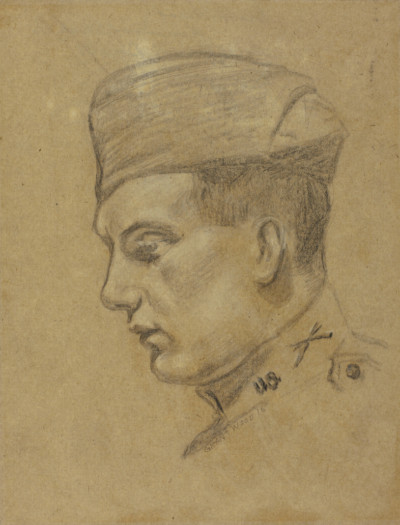Grant Wood was a highly accomplished draughtsman whose skills were developed from a variety of sources. He would famously study at the Académie Julian in Paris in the 1920s as part of his European travels, but much was also learnt from practice and simple observation.
Introduction
Many drawings exist from his career, despite most exposure given to his paintings. There is a good number of study sketches, of varying levels of fidelity, that enable us to both understand his working practices but also to see the raw talent that he possessed. Wood was a curious artist who would take on many different mediums within his career, and was particularly varied in the early part of his life when we was forced to take on different projects in order to develop his reputation and skillset. Some of the drawings that we have left over from his career are considerable in detail and could potentially be presented as finished, giftable artworks in their own right. Having studied some of the great European masters whilst visiting the continent, Grant Wood may have come across the local teaching methods which tended to place a great emphasis on drawing, regardless of which medium the student would want to later specialise in.
Working for the Army
The drawing featured on this page is titled Portrait of Second Lieutenant Wayne McMillen and comes from the permanent collection of the Chicago Art Institute. The artist would have been in his late twenties at the time of this work and we do know that he was employed by the army for a number of years as an artist at around this time (1918). According to the Chicago institution, who also hold a number of other artworks from his career including paintings and lithographic prints, this particular drawing was produced using graphite predominantly. It was then heightened with traces of white gouache which is a technique dating back as far as the great European masters such as Durer, who Wood would have been entirely familiar with. It is likely that the artist would have been limited during his time with the army as to which mediums were available but in later life he would work as a professional artist with his own studio and so make use of different alternatives.
Drawing Mediums
Also within the institution's collection are a number of later drawings which were produced using black crayon. These were on woven cream card which would suggest, particularly considering their size, that the artist worked from a sketchpad on some occasions and would then later remove his favourite pieces and distribute them to friends, family or perhaps sell them on. Some of these drawings were incredibly detailed, and covered different subjects such as portraits or still life pieces. In one memorable piece called The Pump he would recreate every curve and line of a water pump in such a manner that an egineeer might use this as a design plan. That example alone illustrates his excellent technical ability, with several different drawing methods combined together. He would also normally use several mediums, such as here where graphite is added over the initial strokes of crayon. At a later date he would also start to release lithographic prints via a professional publisher, as this enabled him to sell multiple copies of each design. They would be similar in look to his drawings, with a monotone scheme which relied entirely on his subtleties of technique.
Combination with Lithography
We have a number of examples of an unusual approach in the late 1930s where Grant Wood produced the lithograph first, followed by the drawing, before finishing with the oil painting itself. He would sometimes combine white Conté crayon with smudged charcoal to produce different types of finishes and in one series had attempted to capture the different seasons of the year, just as the Impressionists had done in France. It must be remembered that at some points in his career he did work in an Impressionist manner, even though he is best remembered today as more of a Realist, who concentrated on the American rural communities. There are perhaps more of his lithograph prints in circulation today than his drawings, because of the number that could be produced at the time. Earlier in his career he would call upon all manner of other opportunities, including stained glass and textile touches as he attempted to find his calling as an artist. American Gothic would extract all exposure given to his career for many decades, but in recent years there has been more of an attempt to provide a fuller summary of his achievements.




